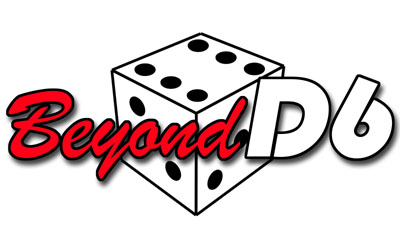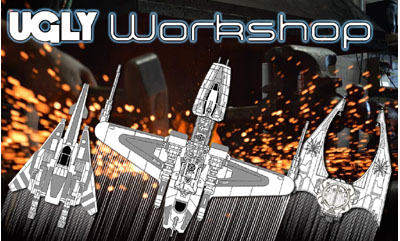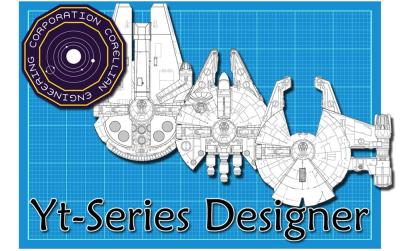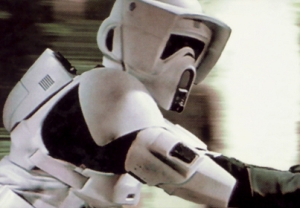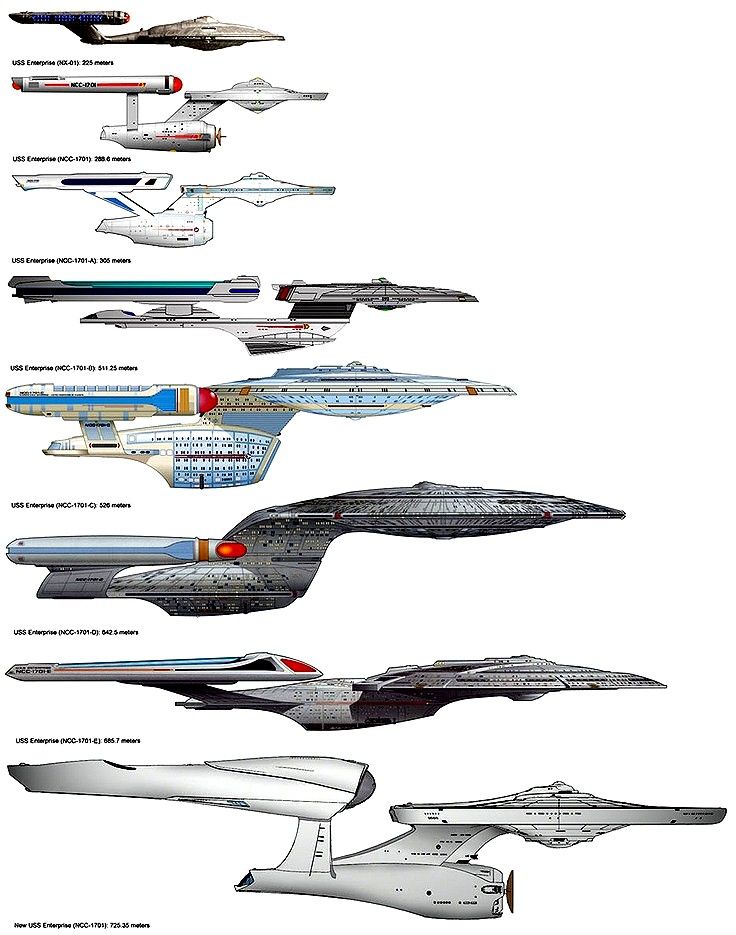 STAR TREK D6 ERA MODIFIER CHART
- - - - - - - - - -
TABLE OF CONTENTS
01-FOREWARD
02-ERA, COST, DECAY MODIFIERS: DIFFERENCES BETWEEN STAR WARS AND STAR TREK
03-AVAILABLITY CODE
04-ERA (AND COST) MODIFIERS
05-DECAY MODIFIERS
06-NOTES ON ERAS OF STAR TREK
07-KELVIN TIMELINE ERA MODIFIERS (2233-2258)
08-MORE/LESS ADVANCED SHIPS
09-STAR TREK VS STAR WARS
10-REFIT AND RETROFIT
- - - - - - - - - -
01-FOREWARD
This Era Modifier Chart is meant to allow GMs/players the use of starships, vehicles, and other technologies from across different eras of the setting with somewhat appropriate modifiers to represent their different technology levels from these different eras. Simply refer to the chart below, the notes for how to use the chart, and the notes below the chart for extra details.
This is based upon and inspired by the Era Modifiers chart found in the first few pages of Star Wars Galaxy Guide 16: The Old Republic (SWGG16), created and posted/published online by The Rancor Pit and the various members there of, and found on starwarstimeline.net. These people do good work and if you are a fan of Star Wars D6, I highly recommend looking up there work, downloading it and pouring through it!
Currently, I have copied/pasted the explanation of those rules from SWGG16 below to explain how to use the chart. While the numbers given in the chart are not the same as for SWGG16, please understand that this chart is for an entirely different setting from Star Wars and should represent Star Trek more. Again, I recommend hunting down SWGG16 and the other works from The Rancor Pit if you are not familiar with them. Once you look at it, this Star Trek version of that chart will make much more sense.
While this write-up uses the Era, Cost, and Decay Modifier charts and rules from SWGG16, there is also a large list of era notes between the Era and Cost sections.
I admit that there may be a mistake somewhere in what I made below. If you see such a discrepency, please feel free to add corrections and optional variants in the comments, or feel free to share how you would have made the chart yourself. Nothing wrong with different perspectives as long as we're all polite.
Now, on to the good stuff!
- - - - - - - - - -
02-ERA, COST, DECAY MODIFIERS: DIFFERENCES BETWEEN STAR WARS AND STAR TREK
What follows here is a copy/pasted quote from SWGG16 for its Era Modifier rules on Star Wars, followed by my own notations explaining differences between Star Wars and Star Trek. This is mostly to help explain the difference between how Star Wars eras cover vast amounts of time over hundreds and thousands of years, where Star Trek covers eras over the course of years and decades, a much shorter timeframe of eras.
ERA MODIFIERS
"Technology advances a lot over a thousand years. While a blaster has been a blaster as far back as anyone can remember, the shields used to deflect it and the armor used to absorb it have advanced considerably over the 25,000 years of known galactic history."
[Actually, in Star Trek technology seems to advance more quickly. I always wondered if this would ever be addressed in Star Wars. My personal house rule or head canon to explain this difference between Star Wars and Star Trek is that Star Wars common technologies take a vastly larger time to propogate across the galaxy due to the distances and people involved. "New stuff" is less about introducing new "game-changing" technologies, and more about taking proven tried-and-tested common, standardized technologies and applying them in new and different ways.
While many ships have the same or similar hyperdrives, shields and weapons (blasters, blaster cannons, triple blasters, laser cannons, turbolasers, concussion missiles, proton torpedoes, etc.), hull materials, and such, these may be installed into a ship hull that has different shapes, sizes, cargo capacity, hangers, and many other varied facilities that decide the purpose of the ship, or other technology being designed and released as a "new product".
To further explain this, Star Wars has various economic power blocs that constantly deal with profits and resources on a galactic scale. This is made prominent during the Clone Wars when organizations like the Trade Federation, Techno Union, and Banking Clans are introduced, each respectively dominating trade, technology, and financial business on the galactic scale. This is furthered by the most well known starship building organizations whose products have become a common sight across most of the Star Wars galaxy and therefor must also handle funds on a galactic scale. These include Corellian Engineering Corp (YT-1300), Sienar Fleet Systems (Imperial Star Destroyers), and the Bilbringi and Sluis-Van shipyards. Because of the scale of funds these organizations handle, introducing some kind of new technology could begin producing galactic scale profits after decades, centuries, or millenia after its introduction, but until such technologies become commonplace across the galaxy. But whichever company releases these new technologies would not see meaningful profits for the forseeable future, and could even see vast losses as the transition is being made.
By contrast, Star Trek interstellar organizations like Starfleet and the Federation operate on a much smaller scale, operating only only a portion of a quadrant of their galaxy, and the common means of travel, warp drive, only allows conventional travel within these smaller areas of space. Therefor new technologies can propogate much quicker, become commonplace sooner, and profits (or other gains, as the Federation does not use normal currencies) can be made within a more reasonable timeframe.]
"For this reason, an optional rule exists to reflect the difference in build strength and technological development between different time periods. When comparing two technological values from items of differing eras - say, a starfighter's blaster and a ship's hull, or a lightsaber blade and a suit of armor - refer to the following chart and subtract the difference between the two eras' die codes from the older item's roll."
[But what if the subtraction gets a 0 or lower? Wouldn't it work better to give a bonus to the more advanced tech? Like the Scale Chart in Star Wars D6 The Roleplaying Game Revised & Expanded (SWD6RE)? If I am missing something here, please leave a comment and let me know.]
"For example, Eran is flying a Rebellion era YT-850 freighter (0D) against a vintage Clone War era ARC-170 fighter (-1D). If the ARC-170 were to fire its laser cannon at the YT-850, the older ship would subtract 1D from its laser's damage roll against the YT's newer hull, to represent the relative difference in armor strength. Consequently, were the YT to return fire, the ARC-170 would be at a -1D penalty for its Hull strength roll against the newer ship's lasers. However, neither ship would be at a penalty when rolling their piloting skill and adding their ship's Maneuver dice, as the rolls are not directly against one another."
"Note that Era Modifiers are NOT applied when a living being's Strength rolls are involved. As there is little to no advancement in the biology of a being from era to era, a blaster bolt is just as damaging to living tissue regardless of which era it was made in. Era Modifiers are used only to represent differences in manufacturing and technology relative to each other."
[Something that just came to mind reading that last bit: what if there WAS a species that advanced or evolved its physiology like this, and these modifiers could be applied to its Strength Attribute? Something to tinker around with later if I ever get aorund to it. However, I am adding this little tidbit here in case anyone else out there likes the idea and wants to take a crack at it.]
COST MODIFIERS
"Similar to technology differences from century to century, the previous table also lists a price modifier for each era. As with the previous codes, the difference in the price modifiers is applied to an item from a previous era being sold in the current era. This multiplier represents the rarity, collectibility, and scarcity of such items."
"For each item, apply the difference in cost modifiers to the object's base cost, and multiply against the item's Availability code. The rarer the object in its own time, the more expensive it will be down the line..."
"For example, Ryloh is attempting to sell a Clone War era Delta-7 Aethersprite fighter to the local resistance to make some quick credits. In her time, the Aethersprite had a cost of 145,000 credits used. During the Rebellion era, Ryloh should be able to get 1.5 times that price, or 217,500 credits, from the right collector."
"Note that the multiplier is NOT allied to an item which is naturally occurring and has no appreciable difference in value to a collector. For example, a cylinder of Tibanna gas is the same in every era, and even being 25,000 years old, has virtually no value difference to a prospective buyer. It will merely end up in the same place as every other canister - a blaster pack. As the saying goes, “no one pays a premium for old Tibanna"."
[Applying that last bit to Star Trek, common resources like dilithium crystals, tritanium alloy, and the many varied substances, materials, and commodities that have been mentioned over the various ST series, movies, etc, would be treated this way and never have a cost modifier].
DECAY MODIFIERS
This is pretty straight forward and needs no further explanation (I hope?).
- - - - - - - - - -
03-AVAILABILITY CODE
SWD6 Availability Code rules added here for quick reference.
Equipment Reference Tables
Availability: This lists where equipment can be found. These codes are general guidelines and local factors may affect an item's availability.
1-Readily available throughout the known galaxy.
2-Normally available only in large cities and space ports, or on the item's planet of origin.
3-Specialized item, normally only available on item's planet of origin.
4-Rare item, difficult to obtain anywhere.
F-Fee or permit often required for purchase.
R-Restricted item on most planets and normally may not be sold without a license.
X-Illegal on most planets. Possession and use generally violates Imperial, New Republic or local laws except for specially authorized individuals. Penalties for use of such an item are often severe.
Pick number and letter and add them together if applicable (examples: medpac would be 1; blaster would probably be 1,F or maybe 1,R in more restrictive locations.
Number can be applied as a multiplier to cost of item being purchased due to supply and demand.
(Optional Rule: Availability number can go higher in certain cases to a 5 showing even more rarity/scarcity on a galactic level, even being a unique one-of a kind item, and cost multiplier can be x5 or even higher due to this. However, such rare items may be considered more as artifacts and plot devices, and could instead be listed as "Not available for sale". Items considered ancient hostprical artifacts would fit this description, but items purposely made in few numbers during current times and having importance or value could have an Availability of 5.)
- - - - - - - - - -
04-ERA MODIFIERS
Era Difference Cost Multiplier
00-Pre-2000 -3D+2 x500
01-Pre-2100 -3D+1 x100
02-Pre-ST:Ent (2120-2150) -3D x50
03-Star Trek: Enterprise (2151-2161) -2D+2 x30
04-Post-ST:Ent (2161-2200) -2D+1 x20
05-Pre-ST:DSC (2200-2240) -2D x10
06-Star Trek: Discovery (2240-2255) -1D+2 x6
07-Star Trek: TOS/TAS (2255-2270) -1D+1 x2
08-Star Trek TOS Movies (2270-2290) -1D x1.5
09-Post ST:TOS Movies (2290-2330) -2 x1.2
10-Pre-ST:TNG (2330-2360) -1 x1.1
11-Star Trek: TNG (2360-2370) 0D x1
12-Star Trek: DS9/Voy (2370-2390) +1 x0.9
13-Star Trek: Picard (2390-2400) +2 x0.8
14-Star Trek Online (2400-2420) +1D x0.7
15-Later 25th Century (2450-2500) +1D+1 x0.6
16-Early 26th Century (2500-2550) +1D+2 x0.5
17-Late 26th Century (2550-2600) +2D x0.4
18-Early 27th Century (2600-2650) +2D+1 x0.3
19-Late 27th Century (2650-2700) +2D+2 x0.2
20-Early 28th Century (2700-2750) +3D x0.1
21-Late 28th Century (2750-2800) +3D+1 x0.09
22-Early 29th Century (2800-2850) +3D+2 x0.08
23-Late 29th Century (2850-2900) +4D x0.07
24-Early 30th Century (2900-2950) +4D+1 x0.06
25-Late 30th Century (2950-3000) +4D+2 x0.05
26-Early 31st Century (3000-3050) +5D x0.04
27-Late 31st Century (3050-3100; The Burn) +5D+1 x0.03
28-Early 32nd Century (3100-3150; Post-Burn) +5D+2 x0.02
29-Late 32nd Century (3150-4000; ST:DSC S3) +6D x0.01
- - - - - - - - - -
05-DECAY MODIFIERS
Separate from the Era Modifiers representing relative technological improvement over time, sometimes you will need to reflect the simple effects of aging on an object - be it a blaster or a starship.
To show the effect neglect and decay have had on an object, consult the following chart and roll the listed damage a number of times consistent with the object's location and the duration of its stay. This represents the damage to various components that may occur over time - the damage, if it occurs at all, might heavily impact just one system, or be spread out over multiple systems.
Roll Damage for:
Location Frequency
Vacuum Every 1,000 years
Light environment (orbit) Every 500 years
Moderate environment (atmosphere) Every 100 years
Dense environment (high gravity) Every 50 days
Amount of Damage:
Condition Damage
Vacuum 2D
Trace gases 2D+2
Standard atmosphere 3D
Heavy atmosphere/fluid 4D
Corrosive atmosphere/particulate* 5D
(blowing sand/ice, asteroids)
Heavy gravitic/tectonic stresses* 6D
* These conditions roll a minimum of once, at -1D, as long as the
object has been sitting for at least a year.
For example, Kon, a pirate in the Rebellion era, has run across a derelict Defender-class transport in deep space. Floating abandoned on the edge of a nebula, the ancient transport looks almost intact… What condition might it be in after all these years? Kon’s player consults the chart and determines that the Defender is 3,600 years old, and has been floating in a near-vacuum with trace gases. Accordingly, he rolls the 2D+2 damage for atmospheric conditions, three separate times (once for each 1,000 years of decay).
Around the same time, Blick discovers an aging Clone War era Jedi Interceptor fighter abandoned in the deserts of Tatooine, near the Jundland Wastes. It looks as though someone tried to cover the vintage vessel with disguise netting, but the harsh winds and desert heat have worn away the cover. Blick’s player consults the chart, and finds that, although the ship has not been sitting long enough in a standard atmosphere to warrant a damage roll (every 100 years), the fact that the atmosphere is corrosive and/or particulate filled (the desert sands of Tatooine are notorious for damaging vehicles), he rolls the minimum damage of 4D (5D-1D).
- - - - - - - - - -
06-NOTES ON ERAS OF STAR TREK
01: (Pre-2120) This era covers anything that might appear or be used before Pre-ST:ENT, but after Earth and Zephram Cochrane discovered and developed warp drive.
02: (2120-2150) Pre-Star Trek: Enterprise. This era includes United Earth starships constructed before the NX-01 Enterprise, but not the NX class itself as it represented the human race's next step in technological development. All ships before the NX-class would be treated with a -1 modifier for being older ships before being given refits with technologies developed and proven on the NX-01 Enterprise itself, as well as later ships and various retrofits and refits of the NX-class itself over the next ten years.
03: (2151-2161) Star Trek: Enterprise. During these ten years, the NX-class pioneers humanity's reach for the stars, and eventually leads humanity and the coalition that will become the Federation of United Planets through the Romulan War. By 2161, after the war and with the birth of the Federation, Enterprise and the NX-class is to be decommissioned to make way for newer, more advanced ships that will lead the way into the future, likely a result of the founding races of the Federation pulling their resources and technologies together for the first time.
04: (2161-2200) Post-Star Trek: Enterprise. This era covers whatever ships would have been developed after the NX-class was retired, but before the Walker-class (U.S.S. Shenzou from ST: Discovery) had been developed.
05: (2200-2240) Pre-Star Trek: Discovery. This era would cover the time when the Walker-class and other ships of its time were first developed and would have been considered new-then-common and not outdated by Starfleet. Other ships taking part in the Battle of the Binary Stars were more than likely newer ships from the next era after this.
06: (2240-2255) Star Trek: Discovery. Other Starfleet ships taking part in the Battle of the Binary Stars would be considered the standard ships of the time. The Crossfield-class (U.S.S. Discovery, U.S.S. Glenn) would be considered among the best of this era's Starfleet ships. The Constitution-class (U.S.S. Enterprise) is relatively new compared to these other ships and may be considered from the next era (+1 modifier), as it was the most advanced starship Starfleet had produced at this time and led the Federation into the next era, with very few starships able to rival it.
07: (2255-2270) Star Trek: The Original Series/The Animated Series. The time of the Constitution-class and the U.S.S. Enterprise, the flagship of Starfleet. While other classes of starship are developed during this time, the Constitution-class cruiser becomes the symbold of Starfleet and the Federation during this time. The class carries Starf;eet through this era until the development of more advanced technologies that gave way to the Miranda-class (U.S.S. Reliant). While the Miranda and other ships with similar technologies become a standard for Starfleet during this time, Constitution-class ships are so respected that many of them receive a complete refit and are updated with these technologies, effectively making them an entirely different ship (+1 modifier for these ships receiving this refot going into the next era).
08: (2270-2290) Star Trek: The Original Series Movies. The Miranda-class and Constitution-class refit comprise technologies that dominate this era. The Enterprise's refit allows it to stay competetive with newer Starfleet ships, made all the better with its veteran crew. During this time the NX prototype U.S.S. Excelsior is developed as a testbed for Transwarp, the ability to travel faster than standard or known Warp speeds. During the theft of the Enterprise the Excelsior attempts to activate its transwarp drive to persue, and instead is left dead in space for reasons currently left unexplained. While the transwarp "Great Experiment" was considered a failure, Excelsior spebds time being converted to using a standard warp drive, and becomes the first in the next line of ships to lead Starfleet into the next era, just as the Constitution-class did previously. However, it is sometime before the Excelsior-class becomes commonplace, and the ship itself is a one-of-a-kind for some time, albeit more powerful than other Starfleet ships of the time (+1 modifier).
09: (2290-2330) Post-Star Trek: TOS Movies. This era sees the rise of the Excelsior-class as Starfleet's standard powerhouse cruiser and eventual workhorse ship, its longevity far outlasting even the Constitution-class by many decades, and is still commonly used through two more eras alongside the Ambassador and Galaxy classes, both ships that surpassed the Excelsior in power and becoming the new symbol of Starfleet. The Miranda-class shares this longevity. The Constellation-class (U.S.S. Stargazer) joins them during this time, but does not seem to have shared this longevity. Excelsior and Miranda classes from later eras may be retrofitted and may receive appropriate era modifiers if they ever enter combat against older versions that have not received such a refit. The U.S.S. Enterprise-B was an Excelsior-class that operated during this time.
10: (2330-2360) Pre-Star Trek: The Next Generation. During this era, the Ambassador-class (U.S.S. Enterprise-C) became Starfleet's mainline cruiser ship, while the Excelsior and Miranda's were relegated to common workhorse ships. The Ambassador-class looks very much like a hybrid of an Excelsior- and Galaxy-class and shows the lineage and evolution of Starfleet technology and starship design over the eras.
(NOTE!: For an alternate take on the Ambassador-class, and what it could have looked like, google up "Star Trek Narendra class", and you're welcome. IMO, if I were to use the Narendra-class in my games, I would say that maybe there were one or two prototypes produced as testbeds that were functional, but that they required too much maintenance to function optimally at all times, and that the Ambassador-class would be what came of the project. That said, this perspective would imply that a Narendra could potentially stand its ground against a Galaxy-class, even better if its systems have been updated going into the next era.)
11: (2360-2370) Star Trek: The Next Generation. During this era Starfleet's premier starship is the Galaxy-class, the most advanced starship they have ever produced. The flagship is the U.S.S. Enterprise-D, which takes part in many adventures and incidents during this time. While the Galaxy-class is very powerful in its own right and holds its own against many powerful threats, it was not built as powerfully as it could have been. This is due to Starfleet and the Federation entering a long-standing era of unprecedented peace and, by extension, complacency. The Galaxy-class and other starships of the time are built for peace and exploration, not for war. While they devote themselves to peace and exploration, Starfleet effectively forgot how to fight in large conflicts. While the Galaxy-class was powerful enough to defend itself in many ship-to-ship fights, this era of peace would begin to come to an end when the Enterprise encounters the Borg, giving Starfleet a collective wake-up call to begin relearning wartime tactics and strategies, and designing ships capable of fighting and winning the conflicts to come. As Starfleet realized it needed to update its fleet, the end of this era is marked bythe following events: the destruction of the Enterprise-D; the launch of the Defiant, first of the Defiant-class and Starfleet's first launched starship built for war in many long decades; the launch of the Sovereign-class, Starfleet's new premier cruiser class, now built for both exploration and combat, proving itself in many battles where a Galaxy-class would likely have succumbed against the threats involved; the launch of several other new classes of ships developed alongside and following the Defiant with fighting the Borg in mind; and finally, the outbreak of the Dominion War where these new ships would not only prove themselves, but be pushed to their limits and beyond.
--: (2370-2380) Star Trek: The Next Generation Movies. This is less of an era, more a mention for posterity. This period of movies starst with the Enterprise-D being destroyed, and being replaced with the more powerful Sovereign-class Enterprise-E in the later films. These films progress alongside the events of Star Trek series Deep Space Nine, which portrays the launch of the Defiant, and Voyager, which follows the travels of the ship of the same name. Together, these movies, DS9, and Voyager portray ships that encompass the next era of technological advancement for Starfleet and the Federation from 2370 onwards.
12: (2370-2390) Star Trek: Deep Space Nine and Voyager. In DS9 the Defiant is launched, beginning the era of new advanced ships for Starfleet, many of which follow later such as the Sovereign-, Akira-, Sabre-, Steamrunner, and Intrepid-class, as well as many others. The film Star Trek: First Contact shows many of these ships living up to their intended purpose to fight the Borg and win (barely). DS9 portrays a much larger and devastating conflict called the Dominion War, where many newer and older classes of Starfleet ships must fight as the war became this bad. Meanwhile, Voyager portrays an Intrepid-class long-range science vessel of the same name sent to the Delta Quadrant of the galaxy and make its way back over time. With the U.S.S. Voyager's introduction, it is stated to be the most advanced ship Starfleet has produced at the time. With other events going it, the Intrepid-class may have been built with Starfleet's newer technologies that also went into the Defiant-, Sovereign- and other classes, but may not have been meant for comnbat. Despite this, many times Voyager held its own against many threats, some punching well above its weight class, modified so many of its systems to handle a wide variety of environments that the ship that left the quadrant was not the one that returned, and even took on the Borg on multiple occasions and won.
13: (2390-2400) Star Trek: Picard. This series does not portray Starfleets advancements during this time except for a few quick exceptions. Instead it focused more on the non-Federation other-side-of-the-tracks roguish elements of that era's interstellar society. While many of these elements are less advanced than previous era Star Trek entries, this side of things also portrays many technologies that were once rare but have now become more commonplace (example: a small ship, the La Sirena, with a crew of one but with the ability to manifest multiple hologram crew members to make up for the lack of crew, who can even fullfill multiple roles, including passenger hospitality (using holograms to alter the appearance of passenger/crew quarters as well), medical, and even a tactical role. While this series has yet to show Starfleet's more advanced side, the end of season one (to date as of this moment, January 6 2021) did portray the arrival of a large fleet of Starfleet state-of-the-art cruisers called the Inquiry-class, led by the U.S.S. Zheng He, commnanded by semi-retired Acting Captain William T. Riker. While these ships did not enter combat, it showed that Starfleet has still been advancing its technology and kept itself sharp for combat if ever needed.
14: (2400-2420) Star Trek Online. This game propels the Star Trek setting to years and decades later, after the end of Star Trek Nemesis when the franchise went on hiatus for many years. It takes everything that has come before, including the mention of Romulus being destroyed in the 2009 Kelvin Timeline films. In this game setting, the story introduces many things both new and old, but most importantly it introduces a motherlode of new ships. Many ships are new visual skins for older ships to represent updating designs that worked well for the new era.
(example: the Galaxy-class has several successor clases in the form of the Celestial-, Envoy-, Monarch, Venture-, Andromeda-, and Ross-classes that follow its design lineage, including Galaxy, Monarch, and Venture Dreadnought refits, and the Yamato devoted Dreadnought clas, while the Intrepid-class (U.S.S. Voyager) has the Cochrane, Discovery, Bellorophon, and Pathfinder successor classes)
While there are many new classes of Starfleet ships during this era and the conflicts that happen during this time (Example: Oddyssey-class and variants, U.S.S. Enterprise-F), any player wanting to use an old favorite class of ship can simply look up what successor variants exist in the game and pick one of these skins that fit a newer, later era (example: the Galaxy-class' variants look like Galaxy type ships but designed using the technologies that went into the Sovereign-class, or even the in-game era-current Odyssey-class, but maintain the general shape of a Galaxy). If using such a "skin-swap", this ship has no need of an refit update because it has been built with current technologies and design philosophies.
15, 18-26: UNKNOWN. There is not much currently known of these eras of the Star Trek franchise. They are listed here for the sake of progressing the Era Modifier Chart up to the time periods that we do have information on. This also means that these eras would be wide open for GMs/players to play in and do with as they please. One possibility to do this would be having a game or campaign set in the Temporal Cold War and involve time travel and conflict between the various factions of the TCW.
16-17: 26th Century. This era was portrayed briefly as relevant in the Temporal Cold War during Star Trek: Enterprise and more so in Star Trek Online. This is also the era where the Universe-class Enterprise-J hails from, a masive starship with highly advanced technology and power that makes all starships of the older eras seem insignificant. While these advancements have not been portrayed in any media (except maybe STO), this ship could be given appropriate stats for its size, and variants of classic weapons with damage dice to match its size and futuristic nature, and perhaps some means of transporting through time as well. During this ship's brief appearance in ST:ENT, other Starfleet ships were seen fighting in a battle in space outside a viewport outside the ship. While these ships looked like older classes of ships, the method mentioned above for updating working ship classes and designs could be used to explain why ships that look like these classes are present during this time, but could in fact be newer, era-current ships. OR, they could be ships from older eras brought forward into the future to take part in open conflict as part of the Temporal Cold War. The Federation during this time is now part of a larger galactic society called the Galactic Union which also includes the Klingon Empire and the Romulan Republic, who finally put aside their differences to form a greater long-lasting whole.
28, 29, 30: (3050-4000) Star Trek: Discovery, Season 3. This is the future era the U.S.S. Discovery arrived in after the end of ST:DSC season 2. In this era, 3189-ish, the galaxy is in bad shape. 130 years earlier (3069) an event happened called "The Burn". All dilithium crystals being used across the galaxy suddenly went inert, the starships using these exploding in uncontrolled matter/anti-matter reactions. The death toll and ensuing chaos was immense and devastating, and over the course of 130 years the Federation went from hundreds or thousands of member worlds to having a mere few dozen as member worlds left to take care of their own, were attacked, suffered other calamities, blamed Starfleet and the Federation, or perhaps other reasons. Starfleet was at a loss of ships and manpower and simply could not handle the crisis. After over a century, Starfleet and the Federation now share the same headquarters where once they were separate entities, and they struggle to protect the member worlds they have left, using any ship that can fly to keep them able to react and help where they can.
The galactic situation is such that Federation/Starfleet joint headquarters must remain hidden for fear of their enemies striking and taking them out once and for all. It is during this era that the U.S.S. Discovery arrives in 3189, rejoins Starfleet, and after a refit that updates the ship to the current era's level of technology, the ship and her crew use their Mycelial Spore Drive as a rapid-responder unit, helping where they can, and hoping to find a way to rebuild the Federation. Many threats lay ahead, such as the EMerald Chain, and this era is not finished being fleshed out yet.
While modifiers are presented for advancing technologies from these eras, Starfleet may in fact to be able to use these modifiers. Due to the enormous backstep forced upon Starfleet and the Federation during these eras, instead of advancing their tech, they instead are struggling and may be forced to use whatever ship that flies that they can get their hands on. For instance, the Discovery would be considered an ancient ship, and while updated, their may be technologies the ship simply may not be able to take advantage of due to being so old. Yet Starfleet would use the ship anyway because it can fly and its one more ship to add to their relatively small fleet than they had yesterday (not to mention its mycelial spore drive that gives it a unique adantage bno other ship possesses).
If applying this option, Starfleet era modifiers during this time would stop at 27 (+5D+2). However, the advancing era modifiers are still provided to represnet other factions that may still be advancing their technology level. One prime example is the Emerald Chain, an enemy faction that develops during this era that seems to control more space and have more ships and manpower, and better technologies than what we see of Starfleet. Late in the season it is stated that the Emerald Chain has protected worlds of free citizens who support The Chain (as well as worlds of slaves), several academic and scientific organizations serving it that could explain their continued development, and seems more than willing to take out the Federation in an open fight if they can locate their headquarters whereas Starfleet actively avoids fighting them due to not having the necessary resources.
Oddly enough, Temporal Agent Daniels (ST:ENT, STO) is supposed to come from the 31st century, and oner is left to wonder how he and other temporal agents are able to operate during this time with all the chaos and Starfleet's lack of resources.
- - - - - - - - - -
07-KELVIN TIMELINE ERA MODIFIERS (2233-2258)
Long story short, when the Nerada and its crew first appeared in the Kelvin timeline, their arrival altered the course of time to create an alternate timeline that from that point on would take a different course than the original timeline. The Nerada's arrival was a big enough change, but this initial even also led to the death of James Kirk's father on the very day he was born, and almost derailed the possibility of him becoming Captain of the Enterprise.
Even though this did play out in a similar fashion, the Nerada was responsible for more changes in this timeline. When Kirk's father's ship, the U.S.S. Kelvin, was destroyed by the Nerada, Kelvin performed in-depth scans of the enemy ship. This data was taken aboard the shuttles the crew used to abandon ship and carried back to Starfleet, who used this data to propel their technology decades ahead of where it would have been otherwise. This is why the Enterprise of this era is so much larger and more powerful.
To complicate matters, when kirk's father sacrificed himself and the Kelvin against the Nerada so the crew would survive, the Klingons came and took the Nerada and its crew captive. They had over two decades to study the ship and learn from it, as well as interrogating the Romulan crew from the future, the entirety of James Kirk's life up to the point he graduated from Starfleet Academy and boarded the Enterprise. What ramifications this could lead to have yet to be seen. This could also explain the power of the U.S.S. Vengeance from Star Trek: Into Darkness.
If GMs/players wish to use ships and tech from the Kelvin Timeline, the Era Modifier for ships from this era would be +1D higher than those of the same era in the original timeline. This also does not account for the Kelvin Enterprise's larger size which would possibky grant it something around +1D Hull/Shield and Weapon Damage dice. I do not make this sound set in stone because some people out there may disagree, and you can change this "optional rule" as you all see fit.
- - - - - - - - - -
08-MORE/LESS ADVANCED SHIPS
Sometimes races will have ships much more or much less advanced than the ships you are using. This was an issue in Star Trek: Enterprise where the NX-01 Enterprise was constantly taking on various starships more powerful than itself, and not always winning either. They even took on ships that had working energy shields when Earth had not figured out this technology yet. To portray this, a difference of +1D/-1D is appropraite, but depending how different the tech level is, GMs could push this further. Referring to that same ST:ENT episode, it wouldn't be too far fetched to think the enemy ship in that episode had an era modifier of +2D, +3D, perhaps even more.
- - - - - - - - - -
09-STAR TREK VS STAR WARS
If GMs/players run games/campaigns that crossover Star Trek and Star Wars, some fans debate over which setting is more advanced than the other. This becomes more complicated when deciding what era of the setting to use in such discussions.
In my own opinion: Star Trek: Enterprise and The Original Series is somewhat similar to the technology level of Star Wars during the original trilogy (0D era modifier)(ignoring the differences between warp drives and hyperdrives for a separate conversation and write-up for later), and anything from Star Trek The Next Generation or later would be considered more advanced (+1D+1, etc).
And of course, someone out there reading this will certainly disagree with the opinion given above, but that's why this section is here to talk about this. Giving my opinion isn't meant to set it in stone, but just to give a simple example, one of many, on how to handle such a situation. If people agree, they can just use that example and go from there. For those who feel differently, it's still pretty simple, and these Era Mofifier Charts are handy to figure out such details. Pick the eras of Star Trek and Star Wars being crossed over from their respective Era Modifier Charts, decide what the difference is in technology level between them, and go from there. That way, if one setting is less advanced than the other, pick a modifier that suits the GM/players (+/-1D in general seems to work), but then remember that if ships from the future or past of their respective settings ever comes into play then they should have appropriate era modifiers from their respective Era Modifier Chart.
- - - - - - - - - -
10-REFIT AND RETROFIT
Refit, retrofit, or maintenance overhaul was the processes by which a piece of technology (such as a starship or any of its components) was overhauled and re-outfitted with newer technology.
REFITS
A refit was the installation of updated equipment aboard a starship. It differed from a retrofit in that the vessel's overall structure was changed during the process. A refit required some form of spacedock. (Star Trek: The Motion Picture; Star Trek V: The Final Frontier; Star Trek VI: The Undiscovered Country).
In game rule terms, this allows players to take their entire ships and the equipment they possess that may be from older eras and suffer Era Modifier penalties in combat, and update the entire ship with modern-era technology so these ships no lonbger suffer such penalties, which go away after the refit process is complete......for a price, of course. After this process is completed, GMs/players should feel free to add or change a visual aesthetic for their ship or other related equipment.
Please keep in mind that this covers refits for ships up to whatever the "modern" era is for the setting being played in. If players wish to push a ship further in tech advancement, this is not impossible, but would obviously cost more and use technologies that have yet to become commonplace in the setting, perhaps even prototypes that have no or very few others of their kind produced currently, and such an upgrade could make the ship a testbed of various new technologies. While a rogue group unaffiliated with any major faction or power would find this very hard to explain (probably stole it), faction-aligned player-characters could receive such a testbed ship or other items as a campaign progresses, and may not have to pay for it at all.
Doing this could still be called a "refit", but could also be referred to as an "upgrade". Ships resulting from such upgrade refits may be referred to as an "advanced" version of its class.
-Refit Cost = 1/4 Base Cost of ship per era modifier (ex: 3 eras difference = 3/4 Base Cost of ship).
-Advanced Refit Cost = 1/2 Base Cost of ship per era modifier.
With Refits updating past ships and equipment to the modern era, these items could be so old that updating them is just impractical due to the cost, hence why entire fleets of starships eventually get replaced by newer, stronger ships designed from the ground up to take advantage of current technologies, which would be considered more cost-effective than continuing to refit starships that are decades old, an issue that was presented during the Stra Trek TNG/DS9 eras. However, some players may do this anyway for a ship they have a fondness for, and if they have enough clout with their faction they could difinitely pull strings to make such a thing happen.
For Advanced Refits installing technologies more advanced that the modern era, depending on the circumstances the price could be raised much higher than thet given above. The price given is for technologies that are in the process of being developed but not ready for release yet. GMs could also have these advanced technologies have "quirks" of some kind that could cause problems when used by the players. One of the purposes of using such technologies is to figure out what such quirks are so that they can be engineered out before the technology is officially released.
For advanced technologies that do not fit this situation, such as time displaced future tech or something more rare, unique, or just plain different from anything being used on the ship (living organic biotechnology?), the cost of the refit should definitely be raised, and if this situation applies to any retrofit installations, the Difficulty for installing such items should be increased as well.
Refit Visual Changes
As mentioned here and in 06-NOTES ON ERAS OF STAR TREK, especially for the game Star Trek Online (STO), many classes of ship have been both refitted with updated technologies and had later classes of ship designed and produced that keep the older class' basic design properties but use newer technologies, effectively producing the same ship that would come from such a refit, but less costly than a refit due to producing the ship with these technologies from the beginning of its design and production instead of refitting the ship several times over the course of years and decades.
If you have access to STO or look through its Gamepedia wiki for certain classes of ships (Galaxy-class and Intrepid-class for a couple of examples), GMs/players can use the class variants shown in the game or on these wiki pages for inspiration for the visual changes made to their own ships when having them go through such refits. Also, if someone is artistically inclined, they could create a sketch or some picture of what they want their refitted ship to look like and show it to the GM and their fellow players.
Examples:
-During the mid-22nd century, the Romulans modified one of their warbirds into a drone ship. (ENT: "The Aenar").
-In 2260 of the alternate reality, the USS Enterprise was repaired and refitted with a new, wider impulse engine as well as new warp drive components on the fins of the nacelles for her first five-year mission. By 2263, the nacelles were replaced with slightly smaller units and the nacelle pylons were swept back away from the primary hull. (Star Trek Into Darkness; Star Trek Beyond).
-The original USS Enterprise underwent a major redesign and refit beginning in 2270 which essentially turned it into a new vessel. The refit, which required eighteen months in Spacedock, involved changing or reconstructing a majority of the ship's systems, including the weapon's systems and warp drive. (Star Trek: The Motion Picture).
-Following the Enterprise's battle with the USS Reliant, Montgomery Scott informed Admiral James T. Kirk that the refit time required until the ship could be taken out again would be eight weeks, but that he could do it in two. Kirk then noted Scotty's propensity to multiply his repair estimates by a factor of four, to which Scotty replied, "How else can I keep my reputation as a miracle worker?" However, Admiral Morrow stated that there would be no refit of the Enterprise, choosing instead to decommission her and reassign Mr. Scott to the USS Excelsior. (Star Trek III: The Search for Spock).
-The USS Enterprise-D underwent a computer refit during its first year (TNG: "Datalore") as well as a very extensive refit after the Borg incursion in 2367. (TNG: "The Best of Both Worlds, Part II", "Family").
-The USS Lakota was refitted in 2372, just before Benteen took command. The refit included upgrades to weapons beyond the norm for an Excelsior-class ship, including quantum torpedoes. (DS9: "Paradise Lost").
-In 3189, the time-displaced USS Discovery received several upgrades as part of a refit to make her suitable for the era, this included detached nacelles, a modified navigational deflector, programmable matter control surfaces, and an enhanced Spore Hub Drive control system. Her registry was also changed by adding a hyphenated letter: A. (DIS: "Scavengers").
RETROFIT
A retrofit was the installation of updated equipment aboard a starship. It differs from a refit in that the vessel's overall structure remained unchanged in the process – the components in question were simply swapped out. A retrofit did not always require a spacedock.
To explain this in game rule terms, it's the same as any other time the players install new weapons, shields, or other equipment or systems on their ship. When doing this, the era modifier still applies to their ship (and other equipment) in combat.
If GMs wish to make exceptions to this general rule, they can do so on a case-by-case circumstance, or make a general rule to cover this. If allowed, when installing weapons and equipment on a ship and the two are from different eras of their setting (or even different universe, such as: installing phasers on a Star Destroyer; or turbolasers on a Defiant-class), use the Cost Modifier to figure out the price of the equipment being purchased and installed. GMs can alter the Cost Modifier for weapons and equipment, as this was meant for ships being purchased as "collectors items", where purchasing and installing outdated shields and weapons on a newer ship should not be more expensive as it puts the ship at a disadvantage and such equipment would rarely be seen as a collector's item, but more as excess surplus than someone would gladly sell if offered the chance.
Flipping this situation around, of the players purchase more advanced weapons and equipment for their ship, the price of these should obviously be more expensive than the stanbdard versions.
After finalizing purchase of the weapons/equipment, what follows is installation. GMs figure out what the Difficulty will be to install the standard versions of these items, then applies a Installation Difficulty Modifier based on what era the items come from.
Retrofit Cost Modifier:
-For each past era the items come from, add +5 to the Difficulty.
-For each future era the items come from, add +10 to the Difficulty.
For past items, one might think these would be easier to install, but the truth is that technology is always marching forward, and as it does past technologies are rarely compatible with current ones. For example, try using a floppy disk with a modern computer. While floppy disks were common in the 1980s-1990s, no computer comes installed with a drive for using floppy disks anymore, let alone any number of components from over 10-20 years ago (as of this write-up in January 2021). One can look online to find an external drive for using floppy disks, but this might also require software installation to set up an emulator, and....well, you see why the +5 modifier per era difference is there.
For future items, the Difficulty is higher per era because it involves using technologies from the future, or rare prototypes to test new concepts, or technologies developed in secret and never meant to be released to the general public. Wherever or whenever they come from, items with a higher era modifier involve technology and technological concepts that are less understood than those of the stanbdard era. While past items may have compaitibility issues, at least these are well understood and documented and work-arounds can be developed (such as those floppy disk external drives for modern computers). With more advanced items, while they might look similar or related to known modern concepts, they will still have differences that are not known and not documented, therefor the compatibility issues are more pronounced. Just being given the slim chance to make use of such items is a blessing, even if it's a Heroic Difficulty one.
Examples:
-A standard part of retrofits (in Star Trek) was to switch out the bridge module of a starship design. Bridge modules might appear radically different from previous versions, while the structure of the starship might remain the same. (Star Trek: The Motion Picture; Star Trek V: The Final Frontier; Star Trek VI: The Undiscovered Country; Star Trek Generations).
-The concept of replaceable bridge modules was developed to explain why the bridge of the Enterprise and USS Enterprise-A appeared completely different over the course of various films, or the USS Enterprise-D between seasons 1 and 2, and season 7 and Generations.
-In late-2370, Captain Keogh asked Chief O'Brien to retrofit Deep Space 9's Danube-class runabouts with an extra complement of photon torpedoes prior to joining the USS Odyssey on a rescue mission to the Gamma Quadrant. (DS9: "The Jem'Hadar")
-In early 2372, Benjamin Sisko told Kasidy Yates that Deep Space 9 was being retrofitted, although in actuality it was being upgraded with new weapons systems. (DS9: "The Way of the Warrior").
|





